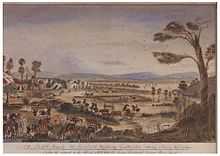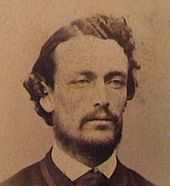Cullin-La-Ringo massacre

The Cullin-la-Ringo massacre or Wills Tragedy occurred north of modern-day Springsure in Central Queensland on 17 October 1861. It remain the largest massacre of white settlers by Aborigines in Australian history, and a pivotal moment in the frontier wars in Queensland.[1]
Massacre

In mid October 1861, a squatter party from the colony of Victoria under Horatio Wills began a temporary tent camp to start the process of setting up the grazing property of Cullin-la-Ringo. Wills's party, an enormous settlement train including bullock wagons and more than 10,000 sheep, had set out from Brisbane eight months earlier to set up a farm at Cullin-La-Ringo, a property formed by amalgamating four blocks of land with a total area of 260 square kilometres (64,000 acres). The size of the group had attracted much attention from other settlers, as well as the indigenous people.
According to the account of one of the survivors, John Moore, Aborigines had been passing through the camp all day on 17 October 1861, building up numbers until there were at least 50. Then, without warning, they attacked, murdering all the men, women and children with nulla nullas. The settlers defended themselves with pistols and tent poles, but nineteen of the twenty-five defenders were killed.

Those killed were Horatio Wills; David Baker, the overseer; his wife, Mrs Baker; their son, David Baker, Jr.; their daughter, Elizabeth Baker; Iden Baker (a young boy); an infant Baker (8 months old); George Elliott; Patrick Mannion; his wife, Mrs Mannion; their three children (Mary Ann Mannion, 8 years old; Maggie Mannion, 4 years old; and baby Mannion, an infant); Edward McCormac; Charles Weeden; James Scott; Henry Pickering; George Ling; and a bullock driver known only as Tom (who had been engaged at Rockhampton).
The six surviving members were Tom Wills (Horatio's son, noted as an outstanding cricketer and co-founder of Australian rules football); John Moore; William Albrey; Edward Kenny; and Patrick Mahony. These men either were absent from the camp or, in Moore's case, managed to avoid being seen. It was Edward Kenny who subsequently rode on to report the massacre, arriving at the neighbouring Rainworth Station the following day. Moore was the only white eyewitness to the event.
Response
"It is not easy that a place so gifted by nature should be the scene of such a cruel massacre".
The first to go out in pursuit were a vigilante party of eleven heavily armed white settlers assisted by two trackers. Judging by the more than fifty camp fires, they pursued what was estimated to be "probably not under 300, and of these 100 may be assumed as the number of fighting men."[3]
The Aborigines continually used ground that prevented the whites from using their horses to full advantage: "they chose stony and difficult ground wherever they had it in their power".[3] Yet the whites eventually managed to catch up with them on 27 November 1861 and at "half-past two a.m. on Wednesday morning their camp was stormed on foot with success."[3] From this account, the number of Aboriginal casualties was very high, although there was no further detail. Another contemporary account said the police "overtook a tribe of natives, shot down sixty or seventy, and ceased firing when their ammunition was expended".[4] They left the remainder to the native police to take on the next run.
Further reading
- The massacre is central to Alex Miller's 2007 historical novel Landscape of Farewell.
- Perrin, Les (1998). dead link] Cullin La Ringo: The Triumph and Tragedy of Thomas Wills. Stafford, Queensland.
See also
Footnotes
- ↑ The Australian Encyclopaedia. Volume 1. Michigan State University Press. 1958. p. 101.
- ↑ Huf, Elizabeth (30 September 2010). "Thomas Wentworth Wills and Cullin-la-ringo Station", Queensland Historical Atlas. Retrieved 2 May 2013.
- ↑ 3.0 3.1 3.2 "THE WILLS' TRAGEDY.". The Sydney Morning Herald (National Library of Australia). 16 November 1861. p. 7. Retrieved 25 August 2014.
- ↑ "The Sydney Morning Herald.". The Sydney Morning Herald (National Library of Australia). 11 December 1861. p. 5. Retrieved 25 August 2014.
References
External links
- New Acquisition – Artwork depicting the "Cullin-la-ringo Massacre" – John Oxley Library Blog, State Library of Queensland
- The Wills Tragedy (Queensland Guardian)
- The Wills Tragedy (The Age)
- Thomas Wentworth Wills and Cullin-la-ringo Station
Coordinates: 24°0′S 148°05′E / 24.000°S 148.083°E
| ||||||